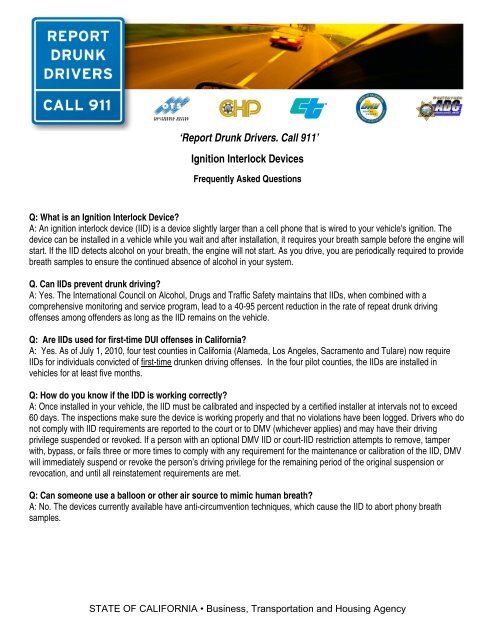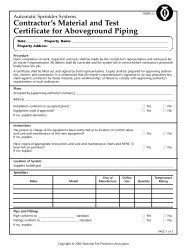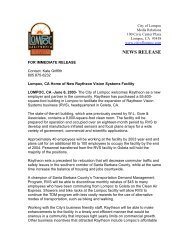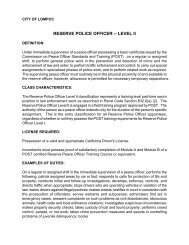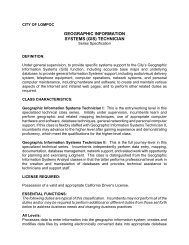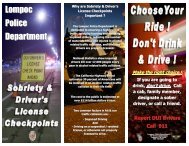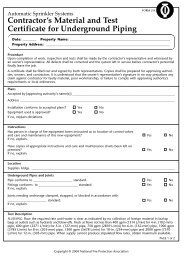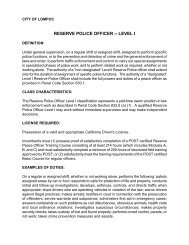Ignition Interlock Devices - the City of Lompoc!
Ignition Interlock Devices - the City of Lompoc!
Ignition Interlock Devices - the City of Lompoc!
You also want an ePaper? Increase the reach of your titles
YUMPU automatically turns print PDFs into web optimized ePapers that Google loves.
‘Report Drunk Drivers. Call 911’<br />
<strong>Ignition</strong> <strong>Interlock</strong> <strong>Devices</strong><br />
Frequently Asked Questions<br />
Q: What is an <strong>Ignition</strong> <strong>Interlock</strong> Device?<br />
A: An ignition interlock device (IID) is a device slightly larger than a cell phone that is wired to your vehicle's ignition. The<br />
device can be installed in a vehicle while you wait and after installation, it requires your breath sample before <strong>the</strong> engine will<br />
start. If <strong>the</strong> IID detects alcohol on your breath, <strong>the</strong> engine will not start. As you drive, you are periodically required to provide<br />
breath samples to ensure <strong>the</strong> continued absence <strong>of</strong> alcohol in your system.<br />
Q. Can IIDs prevent drunk driving?<br />
A: Yes. The International Council on Alcohol, Drugs and Traffic Safety maintains that IIDs, when combined with a<br />
comprehensive monitoring and service program, lead to a 40-95 percent reduction in <strong>the</strong> rate <strong>of</strong> repeat drunk driving<br />
<strong>of</strong>fenses among <strong>of</strong>fenders as long as <strong>the</strong> IID remains on <strong>the</strong> vehicle.<br />
Q: Are IIDs used for first-time DUI <strong>of</strong>fenses in California?<br />
A: Yes. As <strong>of</strong> July 1, 2010, four test counties in California (Alameda, Los Angeles, Sacramento and Tulare) now require<br />
IIDs for individuals convicted <strong>of</strong> first-time drunken driving <strong>of</strong>fenses. In <strong>the</strong> four pilot counties, <strong>the</strong> IIDs are installed in<br />
vehicles for at least five months.<br />
Q: How do you know if <strong>the</strong> IDD is working correctly?<br />
A: Once installed in your vehicle, <strong>the</strong> IID must be calibrated and inspected by a certified installer at intervals not to exceed<br />
60 days. The inspections make sure <strong>the</strong> device is working properly and that no violations have been logged. Drivers who do<br />
not comply with IID requirements are reported to <strong>the</strong> court or to DMV (whichever applies) and may have <strong>the</strong>ir driving<br />
privilege suspended or revoked. If a person with an optional DMV IID or court-IID restriction attempts to remove, tamper<br />
with, bypass, or fails three or more times to comply with any requirement for <strong>the</strong> maintenance or calibration <strong>of</strong> <strong>the</strong> IID, DMV<br />
will immediately suspend or revoke <strong>the</strong> person’s driving privilege for <strong>the</strong> remaining period <strong>of</strong> <strong>the</strong> original suspension or<br />
revocation, and until all reinstatement requirements are met.<br />
Q: Can someone use a balloon or o<strong>the</strong>r air source to mimic human breath?<br />
A: No. The devices currently available have anti-circumvention techniques, which cause <strong>the</strong> IID to abort phony breath<br />
samples.<br />
STATE OF CALIFORNIA • Business, Transportation and Housing Agency
Q: Can a person with an IID restriction have someone else take <strong>the</strong> breath test for <strong>the</strong> driver to start <strong>the</strong> vehicle?<br />
A: Not legally. California Vehicle Code §23247 makes it unlawful for ano<strong>the</strong>r person to blow into an IID or to start a motor<br />
vehicle equipped with <strong>the</strong> device for <strong>the</strong> purpose <strong>of</strong> providing an operable motor vehicle to a person whose driving privilege<br />
is restricted. If <strong>the</strong> car was started illegally, <strong>the</strong> person who started it or ano<strong>the</strong>r sober individual would have to ride in <strong>the</strong><br />
vehicle because <strong>the</strong> unit will randomly ask for a "running retest." If a test is not taken or if <strong>the</strong> test is failed, <strong>the</strong> unit will log a<br />
violation. With some devices, <strong>the</strong> horn will honk until <strong>the</strong> vehicle is turned <strong>of</strong>f. California law imposes fines and/or jail for<br />
individuals assisting in <strong>the</strong> circumvention <strong>of</strong> <strong>the</strong> IID.<br />
Q: Will <strong>the</strong> IID unit lose all memory if <strong>the</strong> battery is disconnected?<br />
A: No. The unit has a back up lithium battery to protect <strong>the</strong> data log's memory.<br />
Q: If a driver gets stranded and thinks <strong>the</strong> IID unit is causing <strong>the</strong> problem, is <strong>the</strong>re anything he/she can do?<br />
A: Some units can self-diagnose problems and <strong>the</strong> driver will be able to confirm if <strong>the</strong> unit is having problems by <strong>the</strong><br />
condition <strong>of</strong> <strong>the</strong> service light. The driver can also call a service provider to help determine if <strong>the</strong> unit requires service.<br />
Q: Can a participant leave his/her car running outside <strong>of</strong> a bar, while drinking inside, and <strong>the</strong>n drive away?<br />
A: If someone tries to do this, <strong>the</strong> unit will randomly ask for breath tests while <strong>the</strong> vehicle is running. If a sample is not given<br />
when requested, <strong>the</strong> device logs a violation and with some devices, <strong>the</strong> horn starts to honk until <strong>the</strong> vehicle is shut <strong>of</strong>f.<br />
Q: What happens when <strong>the</strong> driver forgets his/her service appointment?<br />
A: The device will prompt <strong>the</strong> driver. For example, a device may flash or <strong>the</strong> light may stay on and a tone will sound if it<br />
needs service. If <strong>the</strong> IID is not serviced, all IIDs will enter a lockout condition and <strong>the</strong> driver will not be able to operate <strong>the</strong><br />
vehicle. Then, <strong>the</strong> vehicle would have to be towed to <strong>the</strong> service center or <strong>the</strong> service center technician would have to<br />
perform remote service.<br />
Q: What if <strong>the</strong> driver is taking a medicine with an alcohol base?<br />
A: Alcohol is alcohol. If <strong>the</strong> driver's blood alcohol concentration, as measured in <strong>the</strong> breath, is over <strong>the</strong> preset level, <strong>the</strong><br />
driver will not be allowed to start <strong>the</strong> vehicle. During <strong>the</strong> training session, drivers are particularly cautioned about common<br />
substances that contain alcohol and <strong>the</strong> use <strong>of</strong> mouthwash.<br />
Q: What if <strong>the</strong> driver uses mouthwash in <strong>the</strong> morning and <strong>the</strong> mouthwash has an alcohol base?<br />
A: Again, alcohol is alcohol. If <strong>the</strong> driver does not allow sufficient time for <strong>the</strong> alcohol to dissipate from his/her mouth, a FAIL<br />
will be registered in <strong>the</strong> memory.<br />
Q: What happens when a driver fails <strong>the</strong> breath test?<br />
A: The IID will enter a short lockout period <strong>of</strong> a few minutes for <strong>the</strong> first failed breath alcohol test and a longer lockout for any<br />
subsequent failed breath alcohol test. This permits an opportunity for <strong>the</strong> alcohol to dissipate from <strong>the</strong> mouth and for <strong>the</strong><br />
driver to consider <strong>the</strong> reason for <strong>the</strong> failed breath alcohol test.<br />
Q: Can o<strong>the</strong>rs besides <strong>the</strong> participating driver drive <strong>the</strong> IID-equipped vehicle?<br />
A: Yes. However any intended driver must take and pass a breath test in order to start <strong>the</strong> vehicle. All o<strong>the</strong>r possible drivers<br />
should be trained on <strong>the</strong> operation <strong>of</strong> <strong>the</strong> device. The person with <strong>the</strong> IID restriction is responsible for all readings recorded<br />
by <strong>the</strong> device.<br />
STATE OF CALIFORNIA • Business, Transportation and Housing Agency
Q: What happens when <strong>the</strong> IID-equipped vehicle needs repair?<br />
A: The driver needs to contact <strong>the</strong> IID service provider before having repairs conducted on his/her vehicle in case <strong>the</strong> repair<br />
shop has questions about <strong>the</strong> IID. Documentation must be provided if <strong>the</strong> power to <strong>the</strong> vehicle is interrupted as <strong>the</strong> unit will<br />
record <strong>the</strong> power disconnect and <strong>the</strong> reconnect.<br />
Q: If <strong>the</strong> IID unit malfunctions, will it shut <strong>the</strong> vehicle <strong>of</strong>f?<br />
A: No. The IID unit has no means <strong>of</strong> interrupting vehicle operation once it is started.<br />
Q: What happens if <strong>the</strong> vehicle stalls in traffic?<br />
A: The IID unit permits <strong>the</strong> driver to restart <strong>the</strong> vehicle without having to conduct ano<strong>the</strong>r breath sample, but a breath<br />
sample will be requested shortly after restarting.<br />
Q: What happens if <strong>the</strong> driver is out <strong>of</strong> California and experiences problems with his/her IID unit?<br />
A: Most states currently have IID programs with service centers to assist <strong>the</strong>m. Drivers are instructed to contact <strong>the</strong> primary<br />
service center to be routed to <strong>the</strong> closest center for assistance.<br />
Q: Will installation <strong>of</strong> <strong>the</strong> IID damage <strong>the</strong> vehicle?<br />
A: No. The IID unit is only connected to <strong>the</strong> wiring under <strong>the</strong> dash and under <strong>the</strong> hood. At <strong>the</strong> end <strong>of</strong> <strong>the</strong> program, this wiring<br />
is restored to pre-IID installation conditions.<br />
Q: Will <strong>the</strong> requirements to take a "running retest" cause <strong>the</strong> driver to take his/her eyes <strong>of</strong>f <strong>the</strong> road creating a<br />
hazardous situation?<br />
A: No. When <strong>the</strong> IID signals for a retest, <strong>the</strong> driver has a few minutes to provide <strong>the</strong> sample or to pull over to <strong>the</strong> side <strong>of</strong> <strong>the</strong><br />
road in a safe area to provide <strong>the</strong> breath sample. There are no buttons to push; <strong>the</strong> driver must only brea<strong>the</strong> into <strong>the</strong> unit to<br />
complete a breath sample. This is much simpler than using a cellular telephone or tuning a state-<strong>of</strong>-<strong>the</strong>-art car stereo.<br />
Q: How <strong>of</strong>ten does <strong>the</strong> device need a calibration check?<br />
A: Typically, every 60 days.<br />
Q: Can <strong>the</strong> device be tampered with by computer?<br />
A: No. Proprietary s<strong>of</strong>tware and a special interface connection are needed to communicate with <strong>the</strong> device.<br />
Source: California Department <strong>of</strong> Motor Vehicles.<br />
STATE OF CALIFORNIA • Business, Transportation and Housing Agency


